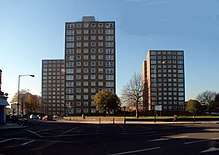Ledbury Estate
Coordinates: 51°28′50″N 0°03′47″W / 51.480449°N 0.063070°W

The Ledbury Estate is a large estate of social housing, in Peckham in the London Borough of Southwark. It is within the Old Kent Road Opportunity Area.[1] The four high rise, H-shaped tower blocks were constructed in the mid-1960s using pre-fabricated concrete panels.
It was found, while making fire safety checks in 2017 in the wake of the Grenfell Tower fire, that the blocks had not been strengthened, as required after Ronan Point collapse in 1968.
Location
The estate is just south of the Old Kent Road, part of the A2 4 kilometres (2.5 mi) from both Tower Bridge and the Elephant and Castle it is adjacent to land used by George Livesey for the South London Gasworks. It consists of houses and maisonettes on Hoyland Close, Commercial Way, Bird in the Bush Road, Naylor Road, Windspoint Drive, Ethward Road and Pencraig Way. There are four thirteen-storey tower blocks Bromyard House, Sarnesfield House, Peterchurch House and Skenfrith House.[2]
Tower blocks
The Ledbury blocks were constructed between 1968 and 1970 using a method called large panel system, in which giant concrete sections were bolted together on site. There was no supporting frame. Many companies produced these building systems,including Tracoba, Camus and Sectra in France, and Jespersen, Skarne and Larsen-Nielsen in Scandinavia. British construction firms such as John Laing and Taylor Woodrow-Anglian used these systems, working for local housing authorities to quickly produce the new homes that were a political necessity in the 1960s. [3]
It was this technique was used at Ronan Point which partly collapsed in 1968 following a gas explosion.
The blocks were constructed for Greater London council using the Larsen-Nielsen method. They are 13 storeys high and contain 56 flats, all except those on the top floor accessible by a lift and stairs, the top floor only by stairs. One lift serves the even numbered floors, and a second lift serves floor 12 and the odd numbered floors. The block is 28m x 20m and 39m to the 13th floor, floor plate [4] They are the form of an H, there are two flats on the each of the long (28m) walls connected by a narrow central service area where one finds the lifts and stairs and a disused drying room. The exterior concrete panels are faced with Norfolk flint. The design is in the Scandinavian point block genre, as found on the Alton Estate rather than following a pure Le Corbusier brutalist (concrete brut) genre. [3]. In front of the flats is a piazza, which forms the roof to a block of subterranean garages which in 2016 were unused. [4]
There are other low rise buildings on the estate constructed by the Larsen-Nielsen method.
History
Ronan point collapse
At Ronan point, a gas stove in an 18th-storey flat caused a series of floors to collapse on to each other. The official investigation said buildings built using the same method must be reinforced, or else have the gas supply removed. Southwark council who took over responsibility for the estate when the Greater London Council was disbanded by the Thatcher government's Local Government Act 1985, said they believed they had been strengthened.[5]
Refurbishment
A scheme is in place to convert the disused garages into a community and training centre with space for small workshops.[1]
Grenfell Tower fire implications
After the Grenfell Tower fire authorities across Great Britain performed additional fire safety checks on all social housing tower blocks. It a block like Skenfrith House, this concentrated on fire doors, evacuation procedures and compartmentalisation: could a fire in one flat be contained for one hour without breaching into an adjacent flat. During this process some residents complained of cracks in the concrete that would allow a piece of paper to pass to the flat above.[4] Ove Arup, was then commissioned to conduct a structural report. The reported that the building had not been strengthened in the early seventies.
Southwark Council announced that strengthening work ordered after Ronan Point may not have been carried out. The gas supply to each block was severed until remedial work had been done. Residents remained in their flats but without, heating, hot water and cooking facilities.[6]
See also
References
Notes
- 1 2 "proposed plans – Livey Exchange/ OKR Studios". liveseyexchange.com. Retrieved 12 August 2017.
- ↑ Norfolk Flint
- 1 2 Livesey Exchange 2017.
- 1 2 3 Innovation Apex 2017.
- ↑ Walker 2017.
- ↑ "South London estate to be evacuated over safety fears - BBC News". BBC Online. Retrieved 10 August 2017.
Bibliography
- Gindrod, John. "Made with Norfolk flint". liveseyexchange.com. Livesey Exchange / OKR Studios. Retrieved 12 August 2017.
- Innovation Apex (30 June 2017). "Fire Safety Assessment Peterchuch Tower PHAU03681001-FRA-PB-4-20170630-145002" (pdf). Southwark Council. Retrieved 12 August 2017.
- Rawlinson, Kevin (11 August 2017). "Gas supplies cut off at Peckham tower blocks at risk of collapse". The Guardian. Retrieved 12 August 2017.
- Walker, Peter (10 August 2017). "London tower blocks residents ordered out over gas safety fears". The Guardian. Retrieved 11 August 2017.